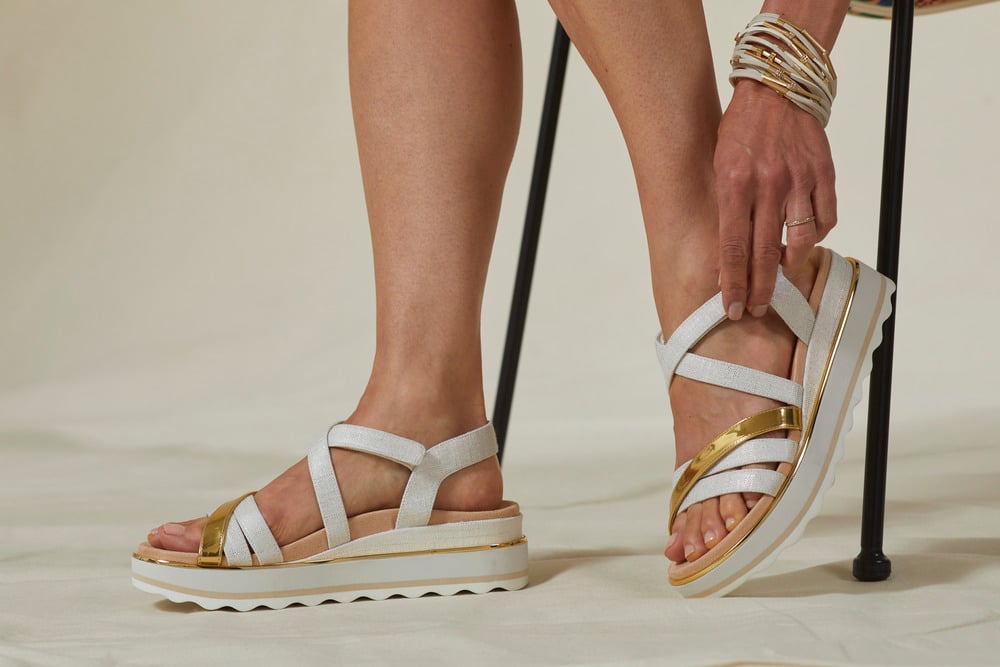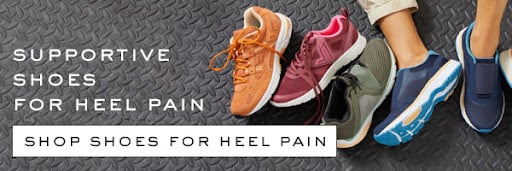
Few things can take the pep out of your step as quickly as foot pain. But as uniquely complex parts of our biology, figuring out why yours feel sore isn’t always as simple as checking your smartwatch and realizing you clocked 10 miles pounding pavement yesterday.
Several circumstances and conditions can cause foot pain, from minor ailments like corn to a more persistent foot problems like Plantar fasciitis or stress fractures. Fortunately, the most common causes of sore feet are avoidable, treatable, and soothable with home remedies and choosing to wear supportive footwear daily.
If you’re stumped as to why you’re experiencing a sharp pain in your every step, we’ll run down 9 possible explanations of sore feet —plus how you can make staying on-the-go feel like a cakewalk.
#1 Wearing Unsupportive Shoe Styles
We choose our shoes based on many factors, from the practical (like comfort, support, or workplace safety) to the vainglorious (namely: fashion). But if you have sore, achy feet at the end of the day, it’s often a sign that the shoes that fit your footwear criteria don’t necessarily fit your feet.
You might try limiting the amount of time you spend wearing footwear styles that can put extra pressure on your feet and ankles. These include:1
- Stilettos and heels
- “Gladiator” style sandals
- Flip-flops
- Ballet flats
- Mules
Remember, you may not need to completely eliminate wearing these shoe styles. But opting for a sturdier, more supportive pair as your regular footwear is a step in the right direction.
#2 Wearing Ill-Fitting Footwear
No matter what style of shoe you’re wearing, it’s important to ensure your shoes fit properly. Every foot is unique, so you can’t always rely on standard sizing when it comes to finding the perfect fit.2
Moreover, just like the rest of the body, our feet change size and shape as we age. Meaning, just because you’ve always worn a size eight doesn’t mean you always will.
Each time you’re purchasing a new pair of shoes, be sure to:
- Have your feet measured (length and width) before purchasing them
- Look for supportive features like arch support or cushioned soles
- Test them out before you make them a permanent fixture in your closet
#3 Blisters, Bunions, Corns, or Calluses
Several minor foot ailments can lead to foot stress and put a stutter in your step:
- Blisters – Blisters are pockets of fluid that form on the top layer of the skin as a result of friction from rubbing, infection, or burns, though standard foot-to-shoe friction is the usual culprit.3 Blisters can vary in size and severity, but there are many ways on how to treat blisters in feet.
- Bunions – A small, hard bump that forms on the interior side of your big toe is known as a bunion. These are caused by a displacement of the bones in the big toe, which forces the end of the toe inward while pushing the base of the toe outward.4
- Corns and calluses – When a part of your foot is put under regular pressure or experiences friction, the skin may form a thick, hard layer known as a corn or callus.5 The skin of the affected area may become dry, flaky, or appear waxy. Corns and calluses can cause chronic foot pain or tenderness, but they tend to go away on their own.
Fortunately, there’s a lot you can do to prevent all three of these conditions and treat them when they develop. Wearing comfortable and supportive shoes is usually the first preventative measure that can also minimize the severity of blisters, bunions, corns, and calluses. Socks that protect your feet from the inside of your shoes can also help.
#4 You’re An Active Person
It might seem obvious, but sometimes, the answer to the question, “why do my feet hurt?” is as simple as spending a lot of time on your feet often. This may be especially true if you’re an athlete, someone who exercises regularly, or a runner.
Several common foot injuries routinely plague active individuals, including:6
- Tendinitis
- Pinched nerves
- Heel spurs
- Stress fractures
If you’re an active person and your feet are bothering you, it might be worth paying a visit to your doctor. They can help you decipher the specific type of foot injury you’re experiencing, whether it indicates a sports-related injury, and discuss your options for staying active without putting undue stress on your body.
#5 Ingrown Toenails
Wondering “why are my feet swollen?” An ingrown toenail develops when the edge or side of the toenail grows into the surrounding skin. This tell-tale foot problem can cause:7
- Sharp, persistent pain and discomfort
- Inflammation and swelling of the skin
- Infection of the affected area
Ingrown toenails are exceedingly common—in fact, an estimated 20% of people who complain of foot pain to their medical providers have them.8 Fortunately, they’re fairly easy to avoid. Exercising caution when trimming your toenails and wearing well-fitting, protective shoes are two of the best ways to keep your toes in the clear. It is also one of the best ways how to reduce swelling in feet.
#6 Plantar Fasciitis
If the sharp pain is localized in your heel, it could be a symptom of Plantar fasciitis, a condition that causes inflammation of the plantar fascia.
The plantar fascia is the band of tissue that runs along the bottom of your foot from your heel to the base of your toes. It’s a thick, durable part of your foot’s structure that provides your feet with arch support and shock absorption.
Plantar fasciitis is characterized by an acute stabbing pain in the heel, which typically peaks in the morning and gradually subsides throughout the day. Plantar fasciitis predominantly affects:9
- Overweight individuals
- People whose occupation requires a lot of time upright
- People between the ages of 40 and 60
- People with exceptionally flat or arched feet
- Dancers and runners
The good news is that most plantar fasciitis suffers are able to alleviate their foot problems on their own by:9
- Physical therapy or developing a foot stretching routine
- Using orthotics and/or night splints
- Regularly icing their feet
- Avoiding strenuous or triggering activities
- Wearing footwear designed with arch support
#7 Tarsal Tunnel Syndrome
Tarsal tunnel syndrome is a condition that affects the ankle, rather than the foot, but foot pain is one of its more common symptoms.10The tarsal tunnel is a narrow passageway between a network of ligaments and bones in the ankle. It acts as a convenient pass-through for the tibial nerve, which runs from just above the knee to the ankle. Sometimes, the bones and ligaments around the tunnel restrict, which can compress or damage the tibial nerve, resulting in tarsal tunnel syndrome.
In addition to foot pain, the condition may also cause:
- Numbness and tingling
- Weakness
- Burning
Because the tarsal tunnel is a syndrome, not a disorder in itself, it can usually be assuaged by treating the condition that brought it on. Taking time to stretch your feet, resting between highly active periods, and prioritizing shoes with arch support can all go a long way in kicking symptoms to the curb.10
#8 Morton’s Neuroma
If you experience a burning pain in the ball of your foot, you may have developed a condition called Morton’s Neuroma. This occurs when the tissues that surround the nerves in your feet and lead to your toes become abnormally dense. In most cases, Morton’s Neuroma affects the area between the third and fourth toes.11
Morton’s Neuroma may also cause the following symptoms in the toes:
- Burning
- Numbness
- Stinging
Sustaining a foot injury can lead to Morton’s Neuroma, as can irritation from friction or pressure. Jogging and running can increase your risk of developing the condition, but wearing poorly fitting shoes and especially high heels can also contribute.
#9 Overusing Your Feet
Finally, the reason your feet hurt may be the most obvious one: your feet are stressed out.
Feet are an impressively resilient part of the body, but they still need a break from time to time! If you’re someone who’s always on the go and are constantly experiencing aching feet, you may be able to mitigate pain by reducing how much time you spend on them.
How do you know how much time should you spend on your feet before letting them rest? It depends on the individual, but these personal and environmental factors may be a reason to give your feet more recovery time:
- Having a heavier body type
- Your medical history, including history of foot or ankle conditions
- Rigorous daily activities (like being an athlete)
- Spending time on uneven terrain or floors
Coupled with shoes that support you no matter what you’re doing, giving your feet time to recuperate after a long shift or a day spent at a festival may be all you need to find relief again.
Tend to Tender Feet With Vionic
When foot pain gets in the way of living your life, one of the best things you can do is slip on a pair of shoes designed for comfort and support. With every design we build, Vionic goes the extra mile to create a shoe that promotes proper foot health by offering orthotic support, stability, and cushioning with every step. We even have the American Podiatric Medical Association’s Seal of Acceptance to prove it.
No matter what’s causing your foot pain, treat your feet to a pair of shoes from Vionic by browsing the latest today.
Sources:
- Hands Down, THESE Are The Worst Shoes For Your Feet.” HuffPost.https://www.huffpost.com/entry/hands-down-these-are-the-worst-shoes-for-your-feet_b_581bad9ee4b01022624114ba
- “10 tips for finding the right shoes.” Harvard Health Publishing. 11 June, 2015.https://www.health.harvard.edu/staying-healthy/10-tips-for-finding-the-right-shoes
- Wilson, Chloe. “Blisters on Feet.” Foot Pain Explored. https://www.foot-pain-explored.com/blisters-on-feet.html#
- “Bunions.” Mayo Clinic.https://www.mayoclinic.org/diseases-conditions/bunions/symptoms-causes/syc-20354799
- “Corns and Calluses.” Mayo Clinic. https://www.mayoclinic.org/diseases-conditions/corns-and-calluses/symptoms-causes/syc-20355946#
- “Common Sports-Related Foot Injuries.” ReboundMD. https://www.reboundmd.com/news/common-sports-related-foot-injuries
- “Ingrown Toenail.” Mayo Clinic. https://www.mayoclinic.org/diseases-conditions/ingrown-toenails/symptoms-causes/syc-20355903#
- “Ingrown toenail: Overview” National Library of Medicine. Institute for Quality and Efficiency in Health Care (IQWiG); 2006.https://www.ncbi.nlm.nih.gov/books/NBK513138/#
- “Plantar fasciitis.” Mayo Clinic. https://www.mayoclinic.org/diseases-conditions/plantar-fasciitis/symptoms-causes/syc-20354846
- “Tarsal Tunnel Syndrome.” Cleveland Clinic.https://my.clevelandclinic.org/health/diseases/22200-tarsal-tunnel-syndrome
- “Morton’s Neuroma.” Mayo Clinic.https://www.mayoclinic.org/diseases-conditions/mortons-neuroma/symptoms-causes/syc-20351935#


Leave a Reply